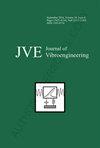利用 WPD 选择频带对复合材料铣削边缘颤振进行频率监测分析
IF 0.7
Q4 ENGINEERING, MECHANICAL
引用次数: 0
摘要
在复合材料的铣削过程中,初始颤振频率并不明显,容易被其他信号淹没,给频率监测带来困难,因此本研究提出了一种基于频率消除算法和小波包分解的颤振频率监测方法。实验结果表明,频率消除算法可以成功去除无效信号,如主轴旋转频率和刀齿频率,只保留必要的信号,此时可观察到颤振频率大致为 1333 Hz。去频后应避免频段 s5、s9、s10、s12 和 s13 的影响,因为它们的能量占比都很低,分别约为 23%、0.9%、5%、10% 和 16%,对颤振的敏感度较低。铣削边缘深度为 0.5 毫米、2 毫米和 4 毫米时,平均颤振阈值分别约为 3.27、2.9 和 2.89。由于经验模态分解观测到的平均颤振能量熵仅为 1.55,并且发现其在铣边深度交界处的波动并不明显,因此要准确定位系统的颤振具有挑战性。另一方面,在铣削边缘深度交界处,能量熵分别约为 2.9、2.6 和 2.5 时,能量熵经历了大幅度的剧烈波动,因此可以明显看出颤振。实验结果表明,频率消除技术和基于小波包分解的颤振频率监测方法可以精确跟踪系统的颤振状态。本文章由计算机程序翻译,如有差异,请以英文原文为准。
Frequency monitoring analysis of milling edge chatter in composites using WPD for frequency band selection
In the milling process of composite materials, the initial chatter frequency is not obvious and is easily swamped by the rest of the signals, making frequency monitoring difficult, so the study proposes a chatter frequency monitoring method based on frequency cancellation algorithms and wavelet packet decomposition. The results of the experiments shown that the frequency cancellation algorithm can successfully remove invalid signals, such as spindle rotation frequency and cutter tooth frequency, and only keep the necessary signals, at which point the chattering frequency may be observed at a frequency of roughly 1333 Hz. The influence of the frequency bands s5, s9, s10, s12, and s13 after de-frequency removal should be avoided because they all have a low energy share of roughly 23 %, 0.9 %, 5 %, 10 %, and 16 %, respectively, and are less sensitive to chatter. For milling edge depths of 0.5 mm, 2 mm, and 4 mm, the average chatter thresholds were around 3.27, 2.9, and 2.89, respectively. It was challenging to pinpoint the chatter of the system because the empirical modal decomposition observed an average chatter energy entropy of just 1.55 and found that its fluctuations at the milling edge depth junction were insignificant. On the other hand, the chattering could be plainly seen since the energy entropy experienced a substantial and dramatic fluctuation at the intersection of the milling edge depth when it was about 2.9, 2.6, and 2.5, respectively. The experimental findings demonstrated that the frequency cancellation technique and wavelet packet decomposition-based chattering frequency monitoring approach can precisely track the chattering state of the system.
求助全文
通过发布文献求助,成功后即可免费获取论文全文。
去求助
来源期刊

Journal of Vibroengineering
工程技术-工程:机械
CiteScore
1.70
自引率
0.00%
发文量
97
审稿时长
4.5 months
期刊介绍:
Journal of VIBROENGINEERING (JVE) ISSN 1392-8716 is a prestigious peer reviewed International Journal specializing in theoretical and practical aspects of Vibration Engineering. It is indexed in ESCI and other major databases. Published every 1.5 months (8 times yearly), the journal attracts attention from the International Engineering Community.
 求助内容:
求助内容: 应助结果提醒方式:
应助结果提醒方式:


